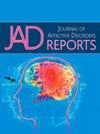Assessing brain morphological correlates of premenstrual symptoms in young healthy females
Q3 Psychology
引用次数: 0
Abstract
While 90 % of females with a menstrual cycle will experience premenstrual symptoms in their reproductive years, it is estimated that 20 % experience treatment-warranted emotional, behavioral, or somatic symptoms in the premenstrual phase of their menstrual cycle. Premenstrual symptoms have been partly attributed to the brain's sensitivity to menstrual cycle-related hormonal fluctuations, which may be modulated by individual differences in the structural characteristics of the brain. In a population-based sample of 292 non-pregnant females aged 23–43 years, we tested for associations between self-reported premenstrual symptom load and T1-weighted MRI based brain measures of cortical thickness, volume, and surface area as well as subcortical volumes, not controlling for menstrual cycle phase. After corrections for multiple comparison, linear models including age revealed significant positive associations between premenstrual symptom load and the volume of the left posterior cingulate cortex. Item-level analyses confirmed that the association with overall symptom load were not driven by specific symptom domains. These findings partly overlap with previous brain morphological findings in individuals with PMS and could possibly represent a non-phase dependent correlate of premenstrual symptoms.
评估年轻健康女性经前症状的脑形态学相关性
有月经周期的女性中,90%的人在生育年龄会出现经前症状,据估计,20%的人在月经周期的经前阶段会出现需要治疗的情绪、行为或身体症状。经前症状部分归因于大脑对月经周期相关激素波动的敏感性,这可能受到大脑结构特征的个体差异的调节。在以人群为基础的292名年龄在23-43岁的未怀孕女性样本中,我们测试了自我报告的经前症状负荷与基于t1加权MRI的大脑皮质厚度、体积、表面积以及皮质下体积之间的关联,而不控制月经周期阶段。经多重比较校正后,包括年龄在内的线性模型显示经前症状负荷与左后扣带皮层体积之间存在显著正相关。项目水平分析证实,与总体症状负荷的关联不是由特定症状域驱动的。这些发现与先前经前综合症患者的脑形态学发现部分重叠,可能代表了经前症状的非期依赖相关性。
本文章由计算机程序翻译,如有差异,请以英文原文为准。
求助全文
约1分钟内获得全文
求助全文
来源期刊

Journal of Affective Disorders Reports
Psychology-Clinical Psychology
CiteScore
3.80
自引率
0.00%
发文量
137
审稿时长
134 days
 求助内容:
求助内容: 应助结果提醒方式:
应助结果提醒方式:


